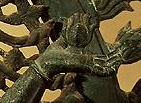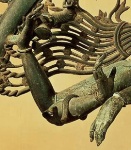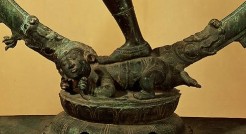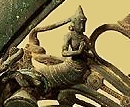The first time that I traveled around Europe, in the summer of 1986, I started my journey in Amsterdam, and made a trip to the Rijksmuseum there. While wandering through the halls of the museum, I was struck by a particular image; I stood staring at this bronze statue, unable to look away. Although I did not know it at the time, this was a depiction of the god Shiva as “Lord of the Dance,” the Nataraja in Sanskrit (nata, “dance”; raja, “lord”). My chance encounter with that fascinating image was the first step in my learning about Indian mythology, a topic that is often not well known or widely studied in America. In this article, I’d like to consider some of the stories that are embodied in this image of Shiva. Before you learn about the stories, however, take a moment to look at the image and see what effect it might have on you: view larger image of this statue.
 Shiva, 12th century bronze. More information »
Shiva, 12th century bronze. More information »
At the most fundamental level, the image tells the story of Shiva, the god who presides over the cosmic cycle of creation and destruction. The dancing Shiva is enclosed within a circular mandala of flames (prabhamandala) shown on a flat, two-dimensional plane, while the gestures of Shiva’s arms and legs describe a circle in space, in three dimensions. With your imagination, you need to supply the fourth dimension — time — which cannot be expressed in the static image: if you stare at the image and let the dancer begin to move, he will start to whirl in a circle, in the direction shone by his left leg which is lifted up and moving towards the right, as is his lower left arm. In addition to the whirling body of the god, you can also see his locks of matted hair whirling around, unbound; Shiva’s hair plays an important role in the god’s iconography and also in the stories told about him.
So what we see here is a cycle, a circle, a whirling dance in which opposed forces are in perfect balance. To read the story of the forces that are both unleashed here and held in check, we need to look at Shiva’s arms (four of them) and his legs. They tell the story of creation and destruction which has happened not just once but over and over again, and not just in the world outside, but in the world within, especially within the hearts of Shiva’s worshipers. Statues like this were of course not originally intended for museums, but instead were venerated in temples and carried in processions during holy days in honor of the god, inspiring dances performed by his followers.
In Shiva’s upper right hand, there is a small hourglass-shaped drum, called a damaru, which provides the music for the dance, and which also symbolizes the act of the creation of the world through sound. The role of sound is an essential force in Hindu cosmology: the Sanskrit language came into being, syllable by syllable, from the sound of Shiva’s drum beating.
In Shiva’s upper left hand, there is a vessel of fire, which symbolizes destruction and dissolution.
 Shiva’s fire (detail). More »
Shiva’s fire (detail). More »
Yet while the upper hands hold the drum of creation and the fire of destruction, Shiva shows the gesture of fearlessness (the abhaya mudra) with his lower right hand. This gesture assures us of the stability of the world. There is a balance at work here, a profound one, and the dancing Shiva stands upright, even as the forces of creation and destruction are whirling around him.
 Shiva’s hands (detail). More »
Shiva’s hands (detail). More »
The lower left hand, meanwhile, turns our attention towards Shiva’s feet, where again we see the balance of two opposing forces. With his right foot, Shiva presses downward, expressing his veiled incarnation in the bodily world (tirobhava). Yet at the same time, with his left foot, Shiva is moving upwards as he bestows a blessing upon his followers, freeing them from the illusion of the world (maya) in an uplifting enlightenment.
Beneath the foot is a demon called Apasmara, who is simultaneously both an enemy of the god being crushed underfoot but also a worshipful devotee who gazes up reverently at the lord. On either side of the demon are two makaras, mythical river beasts like crocodiles. The circle of flames, which seems paradoxically to flow both into and out of their mouths, is another sign of the unbroken circularity of creation and destruction.
Shiva’s face, meanwhile, is peaceful and impassive, expressing the balance of the interplay of forces, up and down, left and right, in and out, which are set in motion during the dance.
This general sense of balance and motion is immediately clear to anyone who gazes at the image; I think it is the sheer beauty of that basic visual impression which captured my rapt attention when I first saw the statue. Then, in addition to the visual language of the statue’s form, there are also symbols (far more symbols than I could cover in this brief article) incorporated into the image which allude to other stories about the god Shiva. Just to take one example, if you look closely, you can find the river goddess Ganga in Shiva’s hair.
This figure alludes to the descent of the goddess Ganga — the river Ganges — through the hair of Shiva. Here is a brief account of that story: The 60,000 sons of King Sagara were chasing a sacred horse which they discovered at the hermitage of the great sage Kapila. Angry at being disturbed in his meditation, Kapila burned them all to ashes. The only way to purify their ashes would be to wash them in the river Ganga, but at that time Ganga was nowhere to be found on the earth; she lived in heaven with the other gods. King Sagara’s pious grandson Bhagiratha prayed to the gods for a thousand years until finally the god Brahma agreed to send Ganga down to earth. Yet Brahma warned Bhagiratha that the force of Ganga’s descent would destroy the world, so Bhagiratha then begged the god Shiva to break the river’s fall. Moved by Bhagiratha’s extreme penances, Shiva agreed to do this, and the floodtide of the Ganga crashed into the locks of his hair, and then splashed safely onto the earth, purifying everything in her path.
The goddess Ganga is just one of the objects shown in the whirling locks of Shiva’s statue. There are other objects there in his hair, and many other stories that the statue tells in this way, calling those myths to mind for audiences who are already familiar with the god and his stories. Yet even without knowing the symbols or the allusions, you can still be swept away by the visual story itself — at least I was, as I gazed for the first time upon the Nataraja in the Rijksmuseum in Amsterdam.




This reminds me a lot of Rand Al’Thor in Robert Jordan’s Wheel of Time series. I am always fascinated to learn more about the background of characters I read of in later fantasy literature. Thanks, Laura!
Hi Ryan! One of the big attractions for the students in my Myth-Folklore and Indian Epics class are exactly those kinds of connections – either to fantasy fiction that they are passionate about, or video games. Have you ever read the Indian epics the Ramayana or the Mahabharata? They really are awesome – I think the reason my students enjoy them so much, the Ramayana especially, is that these sacred ancient Indian texts have a lot in common with modern fantasy writing. The English versions of both the Ramayana and the Mahabharata by William Buck are wonderful if you are interested in giving them a try! :-)
February 23 2009 is Mahashivrati, the annual holiday of Shiva which commemorates the Great Dance. You can read about that at About.com Hinduism’s website: Maha Shivratri: The Night of Shiva :-) Laura
OM NAMASHIVAYA
payday-loan-yes direct pay ppd loans online fast auto payday loans inc